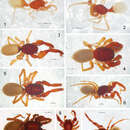Description
provided by Zookeys
Male (holotype): Total length 2.55; carapace, sternum and labium intensive carmine-red; chelicerae, palps (entirely), coxa and femur I light reddish orange, other segments of leg I and entire legs II–IV pale yellowish red; abdomen milk-white with intensive reddish orange dorsal scutum. Carapace (Fig. 10): 1.10 long, 0.76 wide. Diameters of AME, ALE, PLE, PME: 0.10, 0.02, 0.02, 0.02. Interdistances: AME–AME 0.08, ALE–AME 0.05, ALE–PLE <0.01, PLE–PME 0.11, PME–PME 0.14. Chelicerae as shown in Figs 17–18. Sternum (Fig. 11) 0.85 long, 0.65 wide; labium 0.21 long, 0.18 wide at base. Measurements of palp and leg segments as shown in Table 1. Scopulae and tarsal claws as shown in Figs 23, 26–31 and 22, 24, 25, 36, 37 respectively. Scarcely distributed scopular hairs approximately as long as metatarsus and tarsus width (Figs 26–31) At least metatarsus III with comb of setae (Fig. 35). Tarsi I–IV with claw tufts, better developed on tarsi I–II (Figs 22, 24). Tarsal claws I–II with few teeth (Figs 22, 25), III–IV with more and longer teeth (Figs 36, 37). Spinnerets, pedicel tube, and ventral parts of abdominal scutum as shown in Figs 32–34.
Palp (Figs 38–48): femur short and swollen, 2 times longer than wide, subequal in length to tibia and slightly shorter than cymbium. Patella globular. Tibia without apophyses, strongly swollen, 1.5 times longer than wide, 1.3 times wider than femur. Cymbium narrow, shorter than bulb, without outgrowths, with two clusters of hairs on prolateral side (Figs 39, 46). Bulb as wide (in widest part) as long (not counting embolic division and tegular process), tegulum with strong and long retrolateral tegular process (Tp); base of process with conical outgrowth (Co) and deep furrow (Tf); embolus fused with other sclerites of the embolic division (Ed). Embolic division, attached to tegulum by a flexible membrane, and bears embolus (Em) with retrolateral outgrowth (Eo), and lamella (La) located between embolus and cymbium.
Female (paratype): coloration as in male. Total length 2.93. Carapace (Fig. 12): 1.34 long, 0.92 wide. Diameters of AME, ALE, PLE, PME: 0.10, 0.03, 0.02, 0.02. Interdistances: AME–AME 0.08, ALE–AME 0.05, ALE–PLE <0.01, PLE–PME 0.10, PME–PME 0.12. Sternum (Fig. 13) 0.94 long, 0.80 wide; labium 0.22 long, 0.24 wide at base. Measurements of palp and leg segments as shown in Table 1. Spermathecae weakly sclerotised, round, touching each other, each spermatheca with a pair of accessory glands (Figs 49, 50). Due to the weak sclerotisation the outline of the spermathecae and their ducts are not very clear.
Levymanus gershomi, gen. et sp. n., palp and leg measurements (in mm). Male holotype and female paratype (in parentheses). Palp Leg I Leg II Leg III Leg IV Femur 0.19 (0.29) 1.10 (1.36) 0.78 (0.97) 0.78 (0.82) 1.08 (1.19) Patella 0.11 (0.12) 0.88 (1.09) 0.53 (0.69) 0.36 (0.49) 0.47 (0.65) Tibia 0.18 (0.20) 0.71 (0.84) 0.53 (0.73) 0.51 (0.68) 0.69 (0.96) Metatarsus 0.42 (0.53) 0.47 (0.70) 0.60 (0.64) 0.85 (1.11) Tarsus 0.27 (0.25) 0.43 (0.55) 0.36 (0.49) 0.32 (0.39) 0.39 (0.46) Total 0.75 (0.86) 3.54 (4.37) 2.67 (3.58) 2.57 (3.02) 3.48 (4.37)
- license
- cc-by-3.0
- copyright
- Sergei Zonstein, Yuri M. Marusik
- bibliographic citation
- Zonstein S, Marusik Y (2013) On Levymanus, a remarkable new spider genus from Israel, with notes on the Chediminae (Araneae, Palpimanidae) ZooKeys 326: 27–45
- author
- Sergei Zonstein
- author
- Yuri M. Marusik
Distribution
provided by Zookeys
The species is known only from the type locality (Qetura) represented by an extra-arid stony desert at 200–500 m above sea level. All specimens were collected with pitfall traps.
- license
- cc-by-3.0
- copyright
- Sergei Zonstein, Yuri M. Marusik
- bibliographic citation
- Zonstein S, Marusik Y (2013) On Levymanus, a remarkable new spider genus from Israel, with notes on the Chediminae (Araneae, Palpimanidae) ZooKeys 326: 27–45
- author
- Sergei Zonstein
- author
- Yuri M. Marusik

